I will let the following screen shot speak for itself:
Gun Log v3.0 is an Universal App! This means it runs on iPad as well as iPhone and iPod Touch.
The iPhone and iPad versions are identical. The views were changed to use the full screen space available.
While I was updating the code for the iPad I decided to also make the app work with different orientations. Gun Log is designed to be in a portrait layout, but if you wish, you may now rotate your iOS device and the app responds accordingly.
Gun Log iPhone App for logging gun information, range logs and range information, ammunition logs and information, including hand loads, accessory details, and weapon usage reports. Gun Log will never use iCloud or any functionality that shares the data, which was promised when the app was released. View Gun Log on the App Store.
Contact:
slinkworks@gmail.com
Monday, September 26, 2011
Saturday, September 3, 2011
Gun Log 2.5 screen shots
The App Store only allows five screen shots. For an app as complex as Gun Log that is not sufficient to show each area.
The feature set of Gun Log is very large.
Weapons
Here are some current screen shots from Gun Log 2.5.
The feature set of Gun Log is very large.
Weapons
- Make
- Model
- Caliber
- Purchase Information
- Multiple Configurations
- and more!
- Make
- Caliber
- Type
- Bullet Weight
- Ballistic Coefficient
- Bullet Make
- Powder Type
- Muzzle Velocity
- Overall Length
- and more!
- Multiple firing sets per session
- Firing Set information
- Weapon Used
- Configuration Used
- Ammo sed
- Firing Method (Rapid fire, double tap, etc...)
- Firing Stance (Prone, Standing, etc...)
- Rounds Fired
- Group Size
- Failures Records
- Take photograph of target
- Calculate Bullet Drop
- and more!
- Failures
- Firing Sets
- Rounds Fired
- Drop Tables
- and more!
Here are some current screen shots from Gun Log 2.5.
For as many features in weapons, weapon configurations, ammunition, hand-load details, firing sets, maintenance records, failure records, bullet drop estimates, the Gun Log app is a bargain at its current price.
Friday, September 2, 2011
Gun Log version 2.5 is available!
What's New in Version 2.5
Bullet Drop Estimator. In a Firing Set or from a Report the bullet drop can be estimated. In a weapon's configuration specify the sight height in inches above the bore axis and the zero range in yards. In the ammo's details specify the ballistic coefficient (typically a number between .2 and 1.0) and the muzzle velocity. With that data a "drop table" can be calculated that estimates the bullet's vertical position and time of flight. The calculations are based on the G1 ballistic coefficient with the standard assumptions of sea level and other variables.
Okay, this little addition has taken a lot of effort. The Bullet Drop Estimator is reasonably accurate. I have compared the results to a few online calculators as well as compared values to those supplied with ammunition.
To get the best results from the Bullet Drop Estimator you will need to know how high your sight is above the center of the bore. This is known as sight height relative to the bore axis. Also you must specify the range at which the weapon is zeroed. Both the sight height and the zero range is entered into a weapon's configuration. It is done there because the various configurations of say an FN SCAR could be various optics and sights all at different heights.
The muzzle velocity and ballistic coefficient of the bullet must be entered into the ammo details.
The Bullet Drop Estimator can be accessed two ways.
1) Through the Reports area. It is the latest report and at the bottom of the reports list. Just scroll down to see it.
2) Through the firing set. Go to "Sessions" and then tap the button to "Go to Firing Sets...". Select a firing set. Near the bottom of the firing set view there is a button titled "Drop Table..". Just tap that.
Here is a screen shot of the Report area. The Drop Table is at the bottom. Just tap "Drop Table".
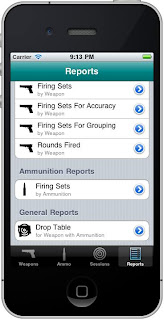
In the "Drop Table" area you can choose the Weapon, Config, and Ammo. Just tap the buttons for each.
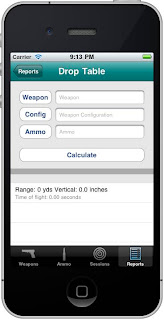
The Config must specify the "Sight Height" and "Zero Distance".
The Ammo must specify the "Ballistic Coefficient" and the "Muzzle Velocity".
Once you have selected the Weapon, Config, and Ammo just tap the "Calculate" button.
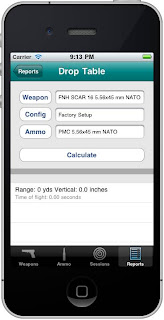

The entire area can scroll. Just drag the data entry area up to reveal more of the table.
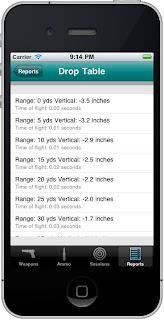
The configuration in this example is zeroed at 200 yards.
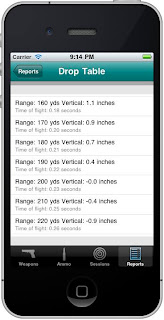
For an example of the data output here I have changed the zero distance to 100 yards.
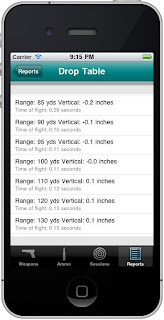
I hope you find this new feature useful. I have been using it for about a month now and find it very useful.
Do not expect this to be as thorough, accurate, extensive, or feature rich as a real external ballistics program, because it is not. It is a good introduction to external ballistics and helps you understand the flight path of a bullet.
Enjoy.
Bullet Drop Estimator. In a Firing Set or from a Report the bullet drop can be estimated. In a weapon's configuration specify the sight height in inches above the bore axis and the zero range in yards. In the ammo's details specify the ballistic coefficient (typically a number between .2 and 1.0) and the muzzle velocity. With that data a "drop table" can be calculated that estimates the bullet's vertical position and time of flight. The calculations are based on the G1 ballistic coefficient with the standard assumptions of sea level and other variables.
Okay, this little addition has taken a lot of effort. The Bullet Drop Estimator is reasonably accurate. I have compared the results to a few online calculators as well as compared values to those supplied with ammunition.
To get the best results from the Bullet Drop Estimator you will need to know how high your sight is above the center of the bore. This is known as sight height relative to the bore axis. Also you must specify the range at which the weapon is zeroed. Both the sight height and the zero range is entered into a weapon's configuration. It is done there because the various configurations of say an FN SCAR could be various optics and sights all at different heights.
The muzzle velocity and ballistic coefficient of the bullet must be entered into the ammo details.
The Bullet Drop Estimator can be accessed two ways.
1) Through the Reports area. It is the latest report and at the bottom of the reports list. Just scroll down to see it.
2) Through the firing set. Go to "Sessions" and then tap the button to "Go to Firing Sets...". Select a firing set. Near the bottom of the firing set view there is a button titled "Drop Table..". Just tap that.
Here is a screen shot of the Report area. The Drop Table is at the bottom. Just tap "Drop Table".

In the "Drop Table" area you can choose the Weapon, Config, and Ammo. Just tap the buttons for each.

The Config must specify the "Sight Height" and "Zero Distance".
The Ammo must specify the "Ballistic Coefficient" and the "Muzzle Velocity".
Once you have selected the Weapon, Config, and Ammo just tap the "Calculate" button.


The entire area can scroll. Just drag the data entry area up to reveal more of the table.

The configuration in this example is zeroed at 200 yards.

For an example of the data output here I have changed the zero distance to 100 yards.

I hope you find this new feature useful. I have been using it for about a month now and find it very useful.
Do not expect this to be as thorough, accurate, extensive, or feature rich as a real external ballistics program, because it is not. It is a good introduction to external ballistics and helps you understand the flight path of a bullet.
Enjoy.
Subscribe to:
Posts (Atom)
















